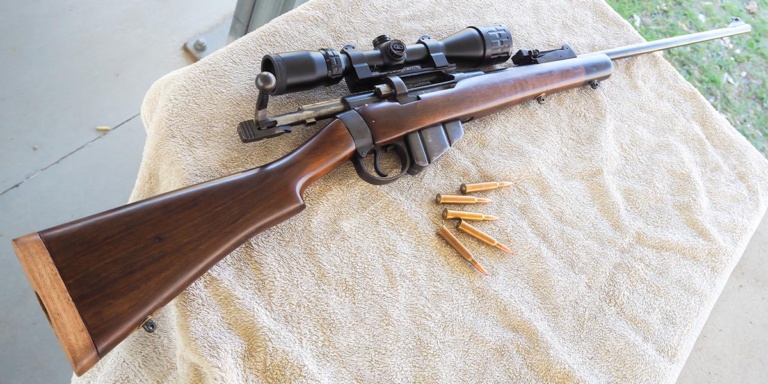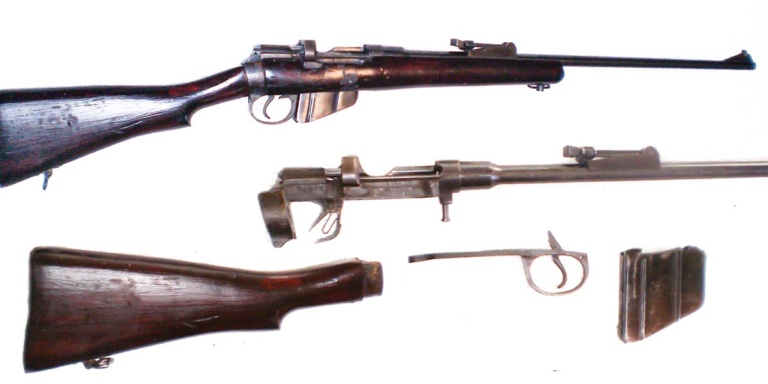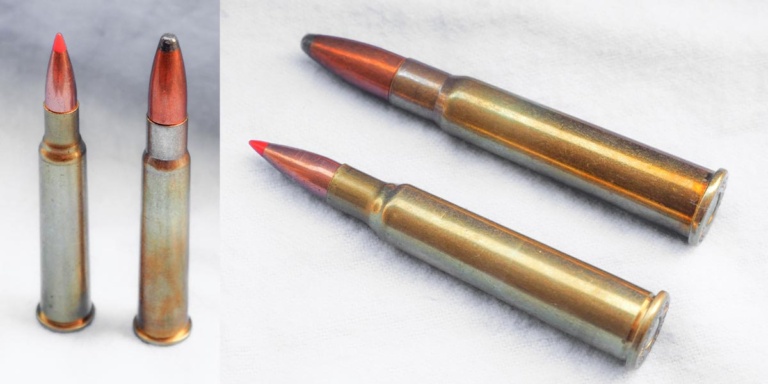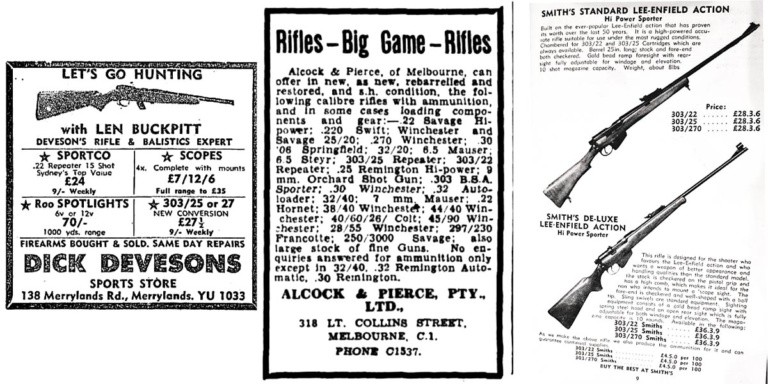The sporterised Lithgow SMLE in .303/25 is an Australian classic, a once-ubiquitous hunting rifle you’d find in gun cabinets and sheds across the land, capable of taking everything from rabbits and roos to deer and even camels with a very well-placed shot!
The calibre is now obsolete and most of the old rifles are long gone, but enthusiasts like my friend Dan keep it alive. Dan, who has an interest in gunstock woodworking, recently acquired a Lithgow SMLE Mk III* in .303/25 with the goal of restoring it to its former glory.
See below to find out why the .303/25 cartridge was invented, and how old military rifles were converted for the civilian market. But first, let’s look at Dan’s restoration.
He found a 1941 Lithgow-made SMLE Mk III* in decent condition, albeit well used. The bolt number matched the action and the bore was in very good condition – an important consideration.

During dismantling of the rifle, the bedding was checked and no issues found. The copper recoil pads were both present and in excellent condition.
The stock wasn’t anything to write home about. It was coated with paint stripper and wrapped in cling wrap to help drive the heat of the stripper back into the timber. Once the paint was soft and bubbling, the stock was unwrapped and thoroughly scraped with a paint scraper.
After the stock dried, the fore-end was cut off straight and reshaped with a sanding block and 120 grit sandpaper. The inletting of the stock was washed with wax and grease remover using a narrow paintbrush to get into the draws, which proved useful for bringing out the excess gun oil and boiled linseed oil.
When the inletting dried, Dan could see there were no cracks or other issues – fortunately!

He sanded the stock using 120 grit sandpaper, progressing in stages to 180 grit as the timber reached a uniform colour and tone.
He then used a soft water-soaked cloth to wet the stock and a hot iron to raise the indentations. This also raised the soft wood grain, allowing it to be sanded out with 220 grit fine-grained sandpaper.
Four progressively finer grits smoothed off the entire stock, and then it was drenched with wet cloth and scorched again with a hot iron between the last two sandpaper grits. This raised any remaining indentations and stood the soft grain up to be sanded.
The process revealed a clearer, more defined grain.
Dan wanted to put a false ebony tip on the end of the stock, so the fore-end was measured 5cm back from the top and ruled at 90 degrees to the top of the barrel channel, before the stock was then very carefully cut.
The fore-end’s front was then measured to mark out holes for dowels, which were inserted and fixed with PVA glue. The tip of the fore-end — which had now been stained using Japan Black tint — was measured, drilled and attached to the dowels in the same fashion.
The length of pull wasn’t quite long enough for Dan so he decided to add an extension, made from Tasmanian oak, using the screw holes for the original brass buttplate to fit dowels. After some shaping and drilling out a hole for the stock bolt, the extension was placed onto the buttstock and hammered into place, before further fitting and filing was undertaken to match the existing stock.
The sling swivel had a metal base that was traced onto the 18mm edge of the Tasmanian oak board, which was then cut off to a thickness of 5mm with a jigsaw.
A timber plug was inserted into the previous sling mounting hole and filed and sanded to shape, while a new sling swivel mounting hole was carefully drilled into the oak extension and a swivel attached.
Dan opened the stock’s barrel channel to a width of 20mm and a depth of 15mm using a plunge router and a box bit.
The stock was coloured with a walnut stain and then cleaned over with cabinetry steel wools in medium and super fine. When he was satisfied with the finish, Dan sprayed the rifle with two-pack gloss clear coating, de-nibbing with ultra-fine steel wool after it had dried.
Finally, he polished the stock with automotive polishing compounds, drilled holes for the sling swivels, and reinforced them with brass washers epoxied into place.
After reassembling the Lithgow, Dan fitted a 3-9×40 scope using an Arctic Fox ‘no gunsmithing’ mount so that the action didn’t have to be modified. The mount also allowed him to retain the original iron sights.
Dan worked up a load involving 39gr of AR2208 behind a 75gr Hornady V-Max projectile in a combination of re-sized modern .303 brass and some contemporary Super-brand .303/25 brass he found at a gun show. Simplex make a reforming die which allows .303 brass to be converted to .303/25, and they also make .303/25 full length reloading dies allowing the brass to be reloaded.

The load grouped around the 1.5 MOA mark or less at 100m – and I’m sure it would be capable of even tighter groupings with practice and in better range conditions than the winds we had to contend with on the day.
Recoil was mild – about the same or even less than I’d expect from a 6.5×55 Swedish Mauser – and I can see why the .303/25 cartridge was so popular for so long.
While .303/25 isn’t likely to be many shooters’ first choice, it is an effective round which served Australian hunters and farmers very well for decades and still has a place in the hearts — and gun cabinets — of a few of us.
WHY THE .303/25?
The immense popularity of the sporterised military rifle chambered in .303/25 was a result of war, ammunition technology, gun laws and cost.
Back in the 1940s and 1950s, centrefire rifle options in Australia were very limited, the majority of the market being ex-military .303s (usually Lithgow-made SMLEs),.32-20 or .25-20 Winchester Model 92s, Martini Cadets in .310 Cadet or .32-20, and some .22 Hornet rifles made by Lithgow.
There was a gap in affordable hunting guns with more power and range than a .32-20 or .44-40 but without quite as large a bullet as the .303 round. Complicating matters further, NSW had laws on the books restricting ownership of “military” calibres (interpreted to mean .303 British), further limiting the options for shooters in that part of the country.
Thanks to the war, SMLE rifles and .303 ammo were everywhere, and cheap. Australian gunsmiths developed the idea of necking down a .303 cartridge to .25 calibre (.257in; 6.5mm), firing an 87gr projectile at more than 2800fps — and in some cases, more than 3000fps.
The idea was to create an all-round cartridge akin to the .243 or 6.5×55 Swedish we all know and love today. Many SMLE, No 4 and Pattern 1914 rifles — as well as a few Mausers — were converted to the round from the 1940s to the 1960s.

The earliest reference I could find to the calibre was an ad dated 26 January 1944 from Melbourne retailer Alcock & Pierce, describing the round as “.303/25 Repeater” and listing it alongside a range of other calibres, including .303/22. The .303/270 was the other common one.
Prominent Sydney-based gun dealer Mick Smith was advertising converted rifles in 1958 for £28/3/6, which is about $885 dollars nowadays, with a deluxe version available for £36/3/9, or about $1135 today.
In the 1960s and 1970s, modern rifles from overseas in newer calibres became more common in the local market at reasonable prices, and the .303/25 rapidly fell out of favour.
The latest ad I could find advertising new .303/25 rifles was February 1963 and it appeared to be for existing stocks, as the last ad referencing newly produced rifles I could find was September 1961.
By the 1980s ammunition was no longer being produced and the guns were being neglected as old sporterised .303s in a weird calibre.
Growing interest in historical firearms, especially those made in Australia, is swinging the balance back to these old rifles, though. Reloading for the .303/25 is not difficult, either: Simplex makes a reforming die which allows .303 brass to be converted to .303/25, and they also make .303/25 full length reloading dies allowing the brass to be reloaded.
So while its heyday has passed, the sporterised Lithgow SMLE in .303/25 remains a great hunting rifle firing a mid-range, high-velocity round. The inherent accuracy of 6mm cartridges remains today, with 6.5×55 Swedish and 6.5mm Creedmoor popular choices among shooters who want accuracy, range, and pleasant shooting from their guns.
Shooters like Dan get that same performance in something that satisfies their passion for history.







0 Comments